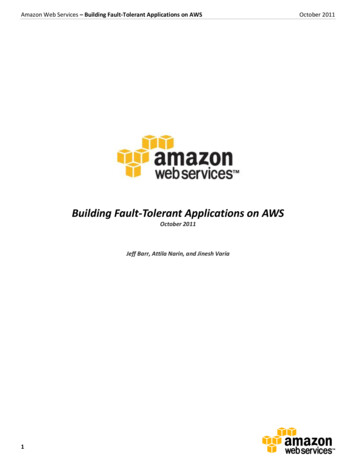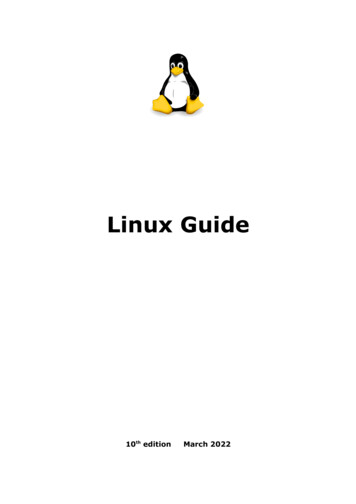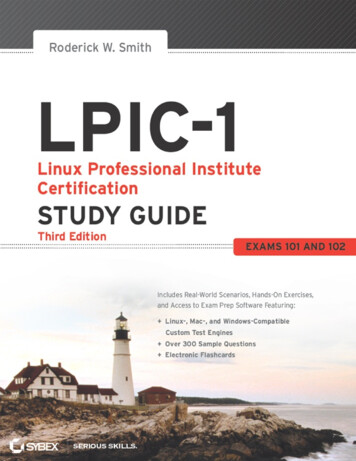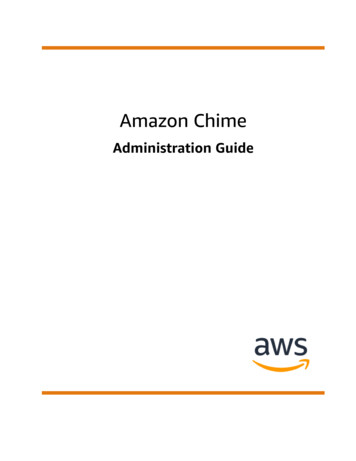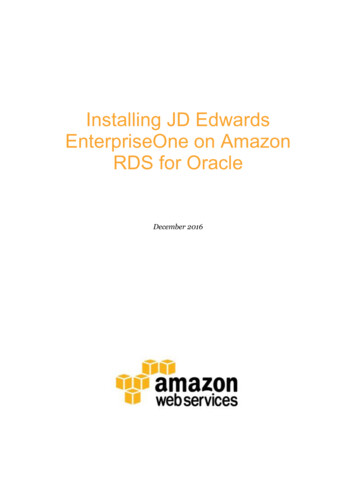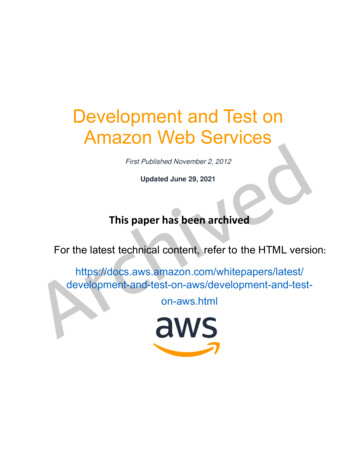
Transcription
Study GuideLPIC-2
ContentsPrerequisites 3Topic 200 - Capacity Planning 3200.1 - Measure and Troubleshoot Resource Usage (System Availability - uptime) 3200.1 - Measure and Troubleshoot Resource Usage (CPU and Disk - iostat) 3200.1 - Measure and Troubleshoot Resource Usage (CPU and Disk - sar) 3200.1 - Measure and Troubleshoot Resource Usage (Memory - free) 4200.1 - Measure and Troubleshoot Resource Usage (Memory - vmstat) 4200.1 - Measure and Troubleshoot Resource Usage (Disk and Files - lsof) 5200.1 - Measure and Troubleshoot Resource Usage (Process Management - ps, pstree, top) 5200.1 - Measure and Troubleshoot Resource Usage (Network and Bandwidth - netstat) 6200.1 - Measure and Troubleshoot Resource Usage (User Information - w) 7200.2 - Predict Future Resource Needs (Gather System Usage Statistics - collectd Intro and Install) 7200.2 - Predict Future Resource Needs (Gather System Usage Statistics - collectd Key Files andLocations) 8200.2 - Predict Future Resource Needs (Gather System Usage Statistics - collectd DisplayStatistics for Capacity Planning) 8200.2 - Predict Future Resource Needs (Gather System Usage Statistics - Awareness of OtherMonitoring Solutions) 9Topic 201 - The Linux Kernel 10201.1 - Kernel Components (Source and Documentation for 2.6.x and 3.x Kernels) 10201.1 - Kernel Components (2.6.x and 3.x Kernel - Terms) 10201.2 - Compiling a Kernel (Getting Everything Ready) 11201.2 - Compiling a Kernel (2.6.x / 3.x General Kernel Compilation) 11201.3 - Kernel Runtime Management and Troubleshooting (LKM - Loadable Kernel Modules) 13201.3 - Kernel Runtime Management and Troubleshooting (depmod and modules.dep) 14201.3 - Kernel Runtime Management and Troubleshooting (Listing, Adding and RemovingModules) 14
201.3 - Kernel Runtime Management and Troubleshooting (Viewing and Changing Kernel Parametersin /proc/sys and Using sysctl) 16201.3 - Kernel Runtime Management and Troubleshooting (Displaying Information About SystemHardware) 16Topic 202 - System Startup 18Topic 203 - Filesystem and Devices 31Topic 204 - Advanced Storage Device Administration 39204.1 Configuring RAID (Preparing Your Devices for Software RAID) 40204.1 Configuring RAID (Configuring Your RAID Device) 41204.1 Configuring RAID (Managing Failure and Recovering RAID Devices) 42204.2 Adjusting Storage Device Access (iSCSI Network Storage - Target Configuration) 43204.2 Adjusting Storage Device Access (iSCSI Network Storage - Initiator Configuration) 43204.2 Adjusting Storage Device Access (iSCSI Network Storage - Mounting and Using the Device) 44204.3 Logical Volume Manager (Physical Volume Group Creation) 45204.3 Logical Volume Manager (Volume Group Creation) 45204.3 Logical Volume Manager (Logical Volume Group Creation) 46204.3 Logical Volume Manager (LVM Maintenance - Extending, Reducing and Resizing LogicalVolumes) 47204.3 Logical Volume Manager (LVM Maintenance - Snapshots) 48Topic 205 - Network Configuration 49Topic 206 - System Maintenance 57
LPIC-2Linux AcademyPrerequisites Linux - CentOS 6 (or other Sysvinit distribution)Topic 200 - Capacity Planning200.1 - Measure and Troubleshoot Resource Usage (SystemAvailability - uptime) uptime Shows how long a system has been running, can be formatted to display in more "humanreadable" format -V, --version Information on uptime container in /var/run/utmp, binary fileVersion information on the utility200.1 - Measure and Troubleshoot Resource Usage (CPU andDisk - iostat) iostat Provides information on both CPU and memory utilization since the last system boot -c Display CPU utilization report -h Add formatting that may be easier for humans to read iostat -c 2 5 Provides CPU information for the user, system, iowait and idle every twoseconds, repeated five times -d - Display the device utilization report Shows the detected block devices (CDROM, SCSI, SATA, IDE, LVM, etc) and their diskstatistics Statistics includes kB read per/s, written per/s, kB read total, kB written total200.1 - Measure and Troubleshoot Resource Usage (CPU andDisk - sar) sar Provides similar information to iostat, but displays it as it occurs over time (generally 10-4-
LPIC-2Linux Academyminute intervals) sar head Shows CPU utilization for user, system and idle (in sum for all CPUs) everydefault time period -d Shows disk utilization for detected block devices (CDROM, SCSI, SATA, IDE, LVM,etc) in TOTAL Displays the device, transfers per second, reads per/s, writes per/s, average request size (insectors), average length of the queue, average time device has taken to serve request (await)and average service time for request (svctime) Part of the "sysstat" package on CentOS 6 and most other sysvinit distributions, may not beinstalled by default Default log files written to are in /var/log/sa and each file is sa#, where the # is the daynumber of the report First time, must be enabled and started to create the log directory and first file chkconfig sysstat on service sysstat start200.1 - Measure and Troubleshoot Resource Usage (Memory- free) free Displays a summary of the virtual memory (including physical RAM and swap) utilization Statistics displayed are total, used, free, shared, buffered/cached and available memory -m Display stats in megabytes -g Display stats in gigabytes -h Tries to shorten the displayed numbers for readability -s ## Polls ## seconds for display200.1 - Measure and Troubleshoot Resource Usage (Memory- vmstat) vmstat Provides more detail on memory than the free utility Values include amount of virtual memory used, idle memory, buffered memory use, cachedmemory use, inactive memory, active memory, swap in/out, blocks in/out, interrupts per/s, context-5-
LPIC-2Linux Academyswitches per/s -a # -t Display active and inactive memory totalsDelay in seconds between output of valuesAdd a timestamp to any output of values -s Display a single table summary of all memory statistics (cannot be repeated withintervals)200.1 - Measure and Troubleshoot Resource Usage (Disk andFiles - lsof) lsof Typically, used to list open files Can be used to provide some disk I/O information when applying some filters as shown lsof head -10 lsof wc -l -u [username] Provides the top ten files that are openProvides a count of the total number of open files on runDisplay open file statistics for that particular user Statistics displayed include the command run, the PID, the terminal ID, the username, thefile descriptor, type of file, the device, the size and the node name (directory) ls -l /dev grep "###, " Displays all devices matching that major devicenumber, pass the full device ID from the command to get one specific device200.1 - Measure and Troubleshoot Resource Usage (ProcessManagement - ps, pstree, top) ps Reports a snapshot of the current processes on a system for the current user (or, as root, theentire system) Statistics displayed include owner of the process, the PID, the parent PID, CPU, start time ofprocess, TTY/Terminal ID, total CPU time over life of process, full command name -e Select and display all processes -f Full format listing, is typically combined with other switches (like -e) to display specificprocesses in more detail pstree-6-
LPIC-2Linux Academy Reports a snapshot of the current process tree on a system for the current user (or, as root, theentire system) Shows indented and ascii-formatted graphical connections between parent and child processesin a tree -a Include command line arguments passed to a process -A Use ascii characters for the tree -G Use VT100 line drawing characters (if possible), makes the display and connectionsvisually clearer -h Highlight the current process -p Include PIDs -Z Include SELinux security context for each process (if SELinux enabled)top Displays a constantly updated list of tasks/processes on a system top isinteractive, keyboard shortcuts change/update the values displayed in real time l Load average t Task/cpu stats m Memory information f Add/remove columns o Change order of column display R Reverse/normal sort order H Show threads n # Set maximum number of tasks to display d Set update interval k Kill task r Renice task q Quit200.1 - Measure and Troubleshoot Resource Usage (Networkand Bandwidth - netstat) netstat-7-
LPIC-2Linux Academy Displays network connections, routing tables, interfaces and related statistics -r Display routing table -s Display a summary of network connection statistics, by protocol -l Display sockets that are in a listening state (for incoming connections) -lt Display only TCP sockets listening -lu Display only UDP sockets listening -n Do not attempt to resolve numeric IPs to name (reverse DNS), speeds up responses -c Continuously update the display -p Includes additional information (application name and its PID)200.1 - Measure and Troubleshoot Resource Usage (UserInformation - w) w Shows who is logged on to the system and what they are doing -s Short format display -i Display IP address instead of hostname of connection (if possible) user Display information on indicated user only200.2 - Predict Future Resource Needs (Gather System UsageStatistics - collectd Intro and Install) collectd Responsible for collecting system statistics; daemon runs constantly Uses plugins to determine the specific statistics that it collects Is not designed as a display mechanism or analyzation engine, but rather a collector of that data There are a number of third-party tools that can display the collected data, that are outsideof the scope of the LPIC2 course /etc/collectd/collectd.conf Daemon configuration file Most settings are commented out, by default-8-
LPIC-2Linux Academy Most global settings will be fine, specific configuration changes will be more likely to bemade on the plugins Amount of time to wait between queries for collectd statistics is defined by theINTERVAL value in the config file Install collectd sudo apt-get install collectd200.2 - Predict Future Resource Needs (Gather System UsageStatistics - collectd Key Files and Locations) collectd Enable the data collection on system startup: Start the service: ckconfig collectd onservice collectd start/usr/share/collectd/types.db Contains one line for each data-set specification, consisting of two field delimited by spaceor tabs First field defines the name of the data-set Second field defines the list of data-source specifications (space or comma delimited) Format is inspired by RRDtool's data-source specification/usr/lib/collectd/rrd/[hostname] Set of directories, one for each plugin enable for that host Each directory contains one or more RRD formatted file containing the statistics for thatdata point as defined in the plugin configuration200.2 - Predict Future Resource Needs (Gather System UsageStatistics - collectd Display Statistics for Capacity Planning) collectd Install the needed packages/dependencies to log the collected data and display it: apt-get install collectd lighttpd git php5 php5-cgiConfigure /etc/php5/cgi/php.ini Find line cgi.fix pathinfo 1 and uncomment it, save and exit the file-9-
LPIC-2Linux Academy Enable modules for lighttpd sudo lighttpd-enable-mod fastcgi sudo lighttpd-enable-mod fastcgi-phpRestart collectd: service collectd restart Start collectd graph panel Clone the cgp (collectd graph panel) cd /var/www git clone http://git.nethuis.nl/pub/cgp.git restart lighttpd1 service lighttpd startView website: http://hostname/cgp/200.2 - Predict Future Resource Needs (Gather System UsageStatistics - Awareness of Other Monitoring Solutions) Nagios Collection of products that include: Nagios XI (Full Enterprise Package), Log Server, NetworkAnalyzer, Fusion, Incident Manager, Core, Reactor Nagios Core is open source, including the collectd-nagios plugin Remaining packages have open source and proprietary components or servicesMRTG MRTG (Multi Router Traffice Grapher) Monitors network traffic load Reads traffic and creates statistics from that information on routers and creates logs for later use Enterprise extensions allow graphing of the data via a web interfaceCacti Also focused on network monitoring Front end for the RRDtool (Round Robin Database tool we installed above) Provides for the display an graphing of data from the tool and can do limited data collection- 10 -
LPIC-2Linux Academy Provides a user management facilityTopic 201 - The Linux Kernel201.1 - Kernel Components (Source and Documentation for2.6.x and 3.x Kernels) 2.6.x kernel source code yum install kernel-devel /usr/src/kernels/[kernel version]2.6.x kernel documentation yum install kernel-doc /usr/share/doc/kernel-doc-[kernel verion]/Documentation Alternate location (some distributions) /usr/src/linux/Documentation3.x kernel source code apt-get source linux-image- (uname -r) /usr/src/linux-[kernel version]3.x kernel documentation Installs with the source code /usr/src/linux-[kernel version]/Documentation Alternate location (some distributions) tion201.1 - Kernel Components (2.6.x and 3.x Kernel - Terms) Kernel images zImage Older systems, designed so the kernel would be stored in "low memory" (the first 640kb ofRAM), was limited to 512kb as a result in order to support older systems (compressed imagesize) bzImage (stands for "big zImage") Low memory limitations are largely a thing of the past and most systems permit kernels tobe loaded in "high memory" (around the 1mb RAM barrier), most modern kernel images are- 11 -
LPIC-2Linux Academyabove 512kb in size (even compressed) Compression types gzip prior to 2.6.x, bzip2 since then Name Typically named with the standard of "vmlinuz-[version]-[architecture]" or "vmlinux[version].[architecture]" Example vmlinuz-3.13.0-36-generic (Ubuntu) or vmlinuz-2.6.32642.3.1.el6-x86 64201.2 - Compiling a Kernel (Getting Everything Ready) Clean the kernel This removes any configurations that are left from other compilations Packages needed: yum groupinstall "Development Tools" yum install ncurses-devel qt-devel hmaccalc zlib-devel binutilsdevel elfutils-libelf-devel All of these tools can be several GB in size, depending on the distribution type alreadyin place (minimum, network, desktop, server, etc) apt-get install ncurses-devel make gccThree types of "clean":1. clean Delete most generated files while leaving enough to build modules2. mrproper Delete the current configuration and ALL generated files3. distclean Remove everything including backup files, leftover patch files, etc. Typical clean command: make clean (runas root , in the kernel source directory)201.2 - Compiling a Kernel (2.6.x / 3.x General KernelCompilation) Distribution specifics There may be certain packages you need to install depending on your distribution, yourdistribution documentation will tell you if there are packages specific to compiling your kernel- 12 -
LPIC-2Linux Academy In general, kernel source, make utilities, zlib utilities and gcc and g are REQUIRED by alldistributions and kernel versions 2.6.x and 3.x differences Other than the source and documentation locations that are listed above the, PROCESS ofcompiling the kernel once the tools and utilities are all in place is the same for each distribution andkernel version Creating the configuration file Main types: make config The most involved type, you will be asked questions on everythingbefore compile can start (100s of them), not generally used anymore except in very specializedcircumstances make menuconfig Most common method, will read .config file in base sourcedirectory as template if it exists, reads existing kernel configuration if not make xconfig Same as make menuconfig but with the X Window QT graphicallibraries make gconfig Same as make menuconfig but with the Gnome Desktop and GTK libraries Create the configuration file: make menuconfig (ncurses device drivers block devices make bzImage (Note: Thiscan take a LONG time and consume a bunch of memory and disk)make modules (Note: Thiscan take a LONG time and consume a bunch of memory and disk)Make the kernel module installation: new .config file in placeMake the kernel modules: normal floppy support (remove/exclude)Compile the new kernel: terminal version)make modules-install (Note: Thiscan take a while, although not quite so long)Copy the new bzImage to the /boot directory: cp /usr/src/linux-[kernel version]/arch/[architecture]/boot/bzImage /boot/vmlinuz-[kernel version].[architecture]- 13 -
LPIC-2 Linux AcademyCreate the initramfs file (which calls the "dracut" utility): mkinitrd /boot/initramfs-[kernel version].[architecture].img [kernelversion] Example mkinitrd /boot/initramfs-3.13.0-36.x86 64.img 3.13.0-36Modify the boot configuration (GRUB) to test Copy the default configuration, referencing your new values Do NOT make it the default on first boot for testing201.3 - Kernel Runtime Management and Troubleshooting(LKM - Loadable Kernel Modules) LKM Modules that are loaded into memory as needed to supplement the functionality of the basekernel Location: /lib/modules Directory should match the value of the uname -a command when choosing frommultiple potential directories uname Print system information -a Print all information -s Just give the kernel name -n Print the network node hostname -r Print kernel release (often used in downloading kernel specific version info like docs orsource) -v Full kernel version -m Machine hardware name -p Processor type -i Hardware (platform) -o Operating systemActual module location for specific kernel:- 14 -
LPIC-2Linux Academy /lib/modules/[kernel version]/kernel Subdirectories contained here break the modules into the general categories that they pertain to(i.e. all sound modules can be found in /lib/modules/[kernel version]/kernel/sounddirectory)201.3 - Kernel Runtime Management and Troubleshooting(depmod and modules.dep) Manually copying a module onto the system (pre-compiled) Place it into the appropriate category (based on documentation: block, sound, fs, etc)Update the module dependencies on the system or the module will not be loadable depmod Looks at all modules under the /lib/modules/[kernel version]/kernel directory Generates files called /lib/modules/[kernel version]/modules.dep and, ifneeded, /lib/modules/[kernel version]/ map Only executed on the current RUNNING kernel by default, specify another kernel version as anargument if desired Example depmod 3.10.0.1-22modules.dep A listing for the modules on the system Each module with two ":" delimited fields:1. Name of the kernel module2. Module it depends on (if no value in 2nd field, no dependency found)201.3 - Kernel Runtime Management and Troubleshooting(Listing, Adding and Removing Modules) lsmod List all LOADED modules Three columns of output:1. Name of the module2. Size of the module (bytes)3. Listing of how many other items (modules, processes, etc) are using the module- 15 -
LPIC-2 Linux Academyrmmod Removes a module from memory Make sure there are no active items using the modules or you could have problems rmmod lp Removes the line printer module from memory, lsmod grep lp shows it is goneinsmod The old method of adding a module to memory Requires that you know the location and exact name of the module Requires that you know the location and exact name of any modules it depends on, loadingthem before insmod /lib/modules/[kernel version]/kernel/drivers/char/lp.ko Loads the line printer module back into memory, confirmed with lsmod grep lpmodprobe New, easier way to add modules into memory You only need to know the name of the module, not its path or dependencies, if there are anyand they exist, they will be loaded automatically modprobe lp modinfo Displays a modules parameters and other applicable information on it Items marked as "parm" are able to be passed to the module upon load Example modprobe lp reset 1 Loads the line printer module back into memory, confirmed with lsmod grep lpAdd the line printer module to the kernel, indicating that it should reset/etc/modprobe.d Directory containing files that allow you to make changes to how modules are loaded Each file lists modules and three primary settings for them1. alias Think of as another way of referring to said module (nickname)2. install Commands and/or parameters to execute when a particular module is loaded intomemory- 16 -
LPIC-2Linux Academy3. remove Commands and/or parameters to execute when a particular module is removedfrom memory (often added to modules that may require that other services be stopped and/orwhen you want specific logging to occur when the module unloads)201.3 - Kernel Runtime Management and Troubleshooting(Viewing and Changing Kernel Parameters in /proc/sys andUsing sysctl) /proc/sys A memory-based filesystem mounted under /proc wherein everything is related to the kernel(including modules), everything is stored in memory (RAM) and NOT on the filesystem itself Values can be changed without a reboot or reload by echoing values into them (overwriting) foreither kernel parameters OR module parameters Example cat "0" /proc/sys/dev/cdrom/autoclose Changes the default value of "true" on the autoclose module to "false"Modifying values this way is temporary until system restartsysctl Displays (and allows you to change) kernel and module parameters on the fly -a Display all kernel and module parameters loaded Example sysctl -a grep cdrom Displays all cdrom module parameters Change a parameter by passing it to sysctl by full name and new value, repeating theautoclose example for CDROM Example sysctl dev.cdrom.autoclose 0 Changes the default value from true to false just as the above /proc/sys methodModifying values this way is temporary until system restartsysctl.conf Permanent changes to overwrite default values are stored here Format is the full device and then equal to the new value Example dev.cdrom.autoclose 0201.3 - Kernel Runtime Management and Troubleshooting- 17 -
LPIC-2Linux Academy(Displaying Information About System Hardware) lspci Lists all hardware devices that are attached to the system directly (permanent attachment, nottemporarily, like USB, although the USB controller itself will be listed) Each single line describes one hardware device in the following format: slot, position, bus number, type, manufacturer, model info, powerspec (if reported),revision (if provided) -v Show additional details (verbose mode), typically shows additional flags and parametersthat are reported -vv Show even more details, including more flags, memory locations or subsystemdesignations -vvv Most verbose mode, show everything the command is able to parse from eachconnected device -k Display the kernel modules that handle the device (both any that are in use, and any thatmight be available) lsusb Older systems (prior to 3.x kernels) may not have this command available Produces output similar to lspci but restricted to connected USB devices, output shows thefollowing Bus ID number, device number (on that bus ID), major manufacture identification number,minor manufacturer device identifier, manufacturer name (of device or primary detected interface) -v Verbose display, typically not used alone because of the amount of information thatwould be displayed -d The device that you want to see more information on; see the lsusb output and obtainthe vendor ID and product ID (in ####:#### format) Example lsusb -v -d 1d6b:0002 Displays a vast array of information about the root USB 2.0 hub on a systemlsdev Another command to display system hardware information Displays the device (location/slot/port), the dma used, the irq used and any I/O ports reported Information from this command is obtained from the /proc/dma, /proc/ioports and /proc/interrupts directories- 18 -
LPIC-2 Linux AcademyLogging hardware information /var/log/message (Red Hat/CentOS systems)Contains kernel messages whenever a newly-detected hardware device is added or removed/var/log/syslog (Debian/Ubuntu systems)Contains kernel messages whenever a newly-detected hardware device is added or removed201.3 - Kernel Runtime Management and Troubleshooting (The Device Filesystem udev) /dev Contains device files that are attached to the Linux system In the past, would contain a number of files for devices that COULD be attached to the systemudevd (daemon) During boot, used to probe connected devices and add the appropriate files to the /devfilesystem After boot, this daemon adds the necessary files to /dev filesystem automatically/etc/udev/rules.d Directory that contains rules that allow you to adjust how these device files are created whendetected The numbers in the front of each name determine the order in which these rules are applied The higher the number, the higher the priority (meaning that a rule starting with 60 couldbe overridden with the rules in a file starting with 90) Each file contains a set of key pair like values, comma separatedudevadm Allows you to monitor what happens when a device is detected and added to the system Example udevadm monitor Prints all the events received for UDEV pertaining to the KERNEL (until killed withCTL-C) udevmonitor Same functionality but for older Linux systemsTopic 202 - System Startup- 19 -
LPIC-2Linux Academy202.1 - Customizing SysV-init System Startup (Linux Standard Base Specification) LSB - Linux Standard Base Specification Joint venture between the Linux Foundation and several Linux distributions An effort to standardize the software system structure (to include the full filesystem hierarchy)of the Linux OS Based on the POSIX specification Binary backward compatibility is maintained with previous versions Designed to produce an ABU (application binary interface) for software vendors to rely on This is achieved (backward compatibility) by adding only new interfaces and notremoving old ones until they have been deprecated at least three revisions (about six years) NOTE: LSB 5.0 released in June 2015 does break compatibility with older versionsand is the first to incorporate the changes made by FHS 3.0 (Filesystem HierarchyStandard) Full support on all versions of Red Hat/CentOS/RPM-based distributions, while Debian-baseddistributions are more limited as a result of the decision to officially support delivery of softwarepackages ONLY on in RPM format (which would need translation to .deb)202.1 - Customizing SysV-init System Startup (SysVInit Boot Process) sysvinit Older system start specification, still only specification on LPIC exams as of 2016Alternatives: upstart (previous Ubuntu versions) systemd (most modern distributions as of 2016 have moved to this service managementmethod) init First process called during the boot, called the init process Used to start all other processes and services What is started is dependent on the runlevel being booted to Runlevels (Red Hat/CentOS) 0 - Halt (Stop) 1 - Single User Mode- 20 -
LPIC-2Linux Academy 2 - Multiuser mode (no GUI or network) 3 - Multiuser mode (no GUI, with network) 4 - Not defined 5 - Multiuser mode (GUI and network) 6 - RebootRunlevels (Debian Based) 0 - Halt (Stop) 1 - Single User Mode 2 - Multiuser mode (GUI and network) 3 - Multiuser mode (GUI and network) 4 - Multiuser mode (GUI and network) 5 - Multiuser mode (GUI and network) 6 - RebootOther runlevels 7,8 and 9 - No standards, most distributions do not define them by defaultGeneral runlevel uses 1 - fixing serious issues, minimal service availability 3 - general "server" runlevel where GUI is not involved 5 - generally considered "desktop" mode with all services plus GUI availability/etc/inittab The file used by the init process to determine the default boot level Multiple values can appear Fields appearing in a line Typical default runlevel definition id:runlevel:keyword:commandExample id:3:initdefault:/etc/rc.d/rc.sysinit A script that is written to allow the system to boot in a basic state- 21 -
LPIC-2 Linux Academy Generally the same as "single user" or "init 1" mode Mounts filesystems, including mounting RAID or LVM block devices Starts key services/etc/rc.d/rc Script that is run whenever the runlevel of a system changes Primary sections are responsible for running START or KILL scripts runlevel Variable that contains the value initially passed into the /etc/init.d/rc script to determinethe runlevel to which to change /etc/rc.d/rc#.d Directory corresponding to the desired runlevel that contains start scripts (beginning with acapital "S" and then a number between 1 and 99) or kill scripts (beginning with a capital "K" andthen a number between 1 and 99) Each of the start/kill scripts is actually a link to the appropriate service file in /etc/init.d This structure facilitates easily adding/removing services from each runlevel by adding/removing links that will not affect the underlying service itself Naming convention for start/stop files S[1-99]servicename K[1-99]servicename Numbers designate the order that each start or kill script is executed in, it allows adependency build Example S13hostname is executed only AFTER the S10network script is called(because we do not want to set a hostname before starting the network)202.1 - Customizing SysV-init System Startup (/etc/init.d and Modifying RunlevelsScripts) /etc/init.d Where the actual service scripts are installed in a sysvinit system Linked to by the various rc#.d directories and the contained start/kill scripts Can be used to directly start a service daemon if desired Example sudo /etc/init.d/nginx start- 22 -
LPIC-2Linux Academy Location where custom scripts are located that can be added to the runlevelsupdate-rc.d -NOTE: DEBIAN AND UBUNTU SYSTEMS ONLY Program to create the links from the /etc/rc#.d directories to the named script Example upd
Nagios Collection of products that include: Nagios XI (Full Enterprise Package), Log Server, Network Analyzer, Fusion, Incident Manager, Core, Reactor Nagios Core is open source, including the collectd-nagios plugin Remaining packages have open source and proprietary components or services MRTG



![Index [beckassets.blob.core.windows ]](/img/66/30639857-1119689333-14.jpg)
